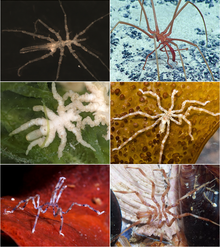
Back عنكبوت البحر Arabic عنكبوت البحر ARZ Pycnogonida AST Dəniz hörümçəkləri Azerbaijani دنیز هؤرومچکلری AZB Марскія павукі Byelorussian Морски паяци Bulgarian Picnogònids Catalan Kaka sa dagat CEB Nohatky Czech
| Sea spiders Temporal range:
| |
|---|---|

| |
| Left to right, top to bottom: Austrodecus bamberi (Austrodecidae), Colossendeis sp. (Colossendeidae), Pycnogonum stearnsi (Pycnogonidae), Ammothea hilgendorfi (Ammotheidae), Endeis flaccida (Endeinae), Nymphon signatum (Nymphonidae) | |
| Scientific classification | |
| Domain: | Eukaryota |
| Kingdom: | Animalia |
| Phylum: | Arthropoda |
| Subphylum: | Chelicerata |
| Class: | Pycnogonida Latreille, 1810 |
| Order: | Pantopoda Gerstaecker, 1863 |
| Type genus | |
| Pycnogonum Brünnich, 1764
| |
| Families | |
|
See text. | |
| Synonyms | |
|
Arachnopoda Dana, 1853 | |
Sea spiders are marine arthropods of the order Pantopoda[1] (lit. ‘all feet’[2]), belonging to the class Pycnogonida,[3] hence they are also called pycnogonids (/pɪkˈnɒɡənədz/;[4] named after Pycnogonum, the type genus;[5] with the suffix -id). They are cosmopolitan, found in oceans around the world. The over 1,300 known species have leg spans ranging from 1 mm (0.04 in) to over 70 cm (2.3 ft).[6] Most are toward the smaller end of this range in relatively shallow depths; however, they can grow to be quite large in Antarctic and deep waters.
Although "sea spiders" are not true spiders, nor even arachnids, their traditional classification as chelicerates would place them closer to true spiders than to other well-known arthropod groups, such as insects or crustaceans, if correct. This is disputed, however, as genetic evidence suggests they may be a sister group to all other living arthropods.[7][8]
- ^ "Pycnogonida". World Register of Marine Species. Taxon details.
- ^ "Pantopoda". Merriam-Webster.com Dictionary.: "taxonomic synonym of Pycnogonida < Neo-Latin, from pant- + -poda"
- ^ "Pycnogonida". Merriam-Webster.com Dictionary.: "New Latin, from Pycnogonum [...] + -ida"
- ^ "pycnogonid". Merriam-Webster.com Dictionary.
- ^ "pycnogonid". The Free Dictionary.
From Neo-Latin Pycnogonida, class name, from Pycnogonum, type genus.
- ^ "Sea spiders provide insights into Antarctic evolution" (Press release). Department of the Environment and Energy, Australian Antarctic Division. 22 July 2010. Archived from the original on 31 July 2018. Retrieved 27 December 2017.
- ^ Regier, Jerome C.; Shultz, Jeffrey W.; Zwick, Andreas; Hussey, April; Ball, Bernard; Wetzer, Regina; Martin, Joel W.; Cunningham, Clifford W. (2010). "Arthropod relationships revealed by phylogenomic analysis of nuclear protein-coding sequences". Nature. 463 (7284): 1079–83. Bibcode:2010Natur.463.1079R. doi:10.1038/nature08742. PMID 20147900. S2CID 4427443.
- ^ Sharma, P. P.; Kaluziak, S. T.; Perez-Porro, A.R.; Gonzalez, V. L.; Hormiga, G.; Wheeler, W. C.; Giribet, G. (2014). "Phylogenomic Interrogation of Arachnida Reveals Systemic Conflicts in Phylogenetic Signal". Molecular Biology and Evolution. 31 (11): 2963–84. doi:10.1093/molbev/msu235. PMID 25107551.
© MMXXIII Rich X Search. We shall prevail. All rights reserved. Rich X Search